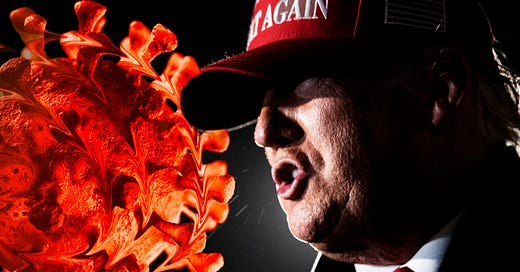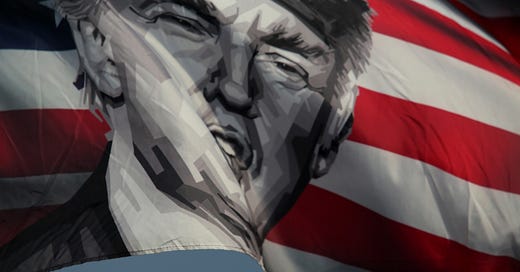
How the Trump Administration Twisted Coronavirus Intelligence
Rather than use intelligence to inform the government's response to the pandemic, the Trump administration tried to bend the facts for political ends.
Two stories reported by CNN yesterday seem to conflict. At the same time that President Biden asked the intelligence community to redouble its efforts to uncover the origins of SARS-CoV-2, the virus that causes COVID-19, he also shut down an investigation by the State Department looking into the virus’s genesis. (A State Department spokesman indicated that the investigation ended, rather than being canceled.) How could the president both ask the intelligence community to look more closely at where COVID-19 came from, and ask the State Department, which includes an intelligence bureau, to stop? The answer lies in the Trump administration’s politicization of intelligence related to SARS-CoV-2, which I saw firsthand in the White House.
President Trump was first briefed about the novel coronavirus emerging in China on January 23 and 28, 2020. Vice President Pence, for whom I served as homeland security and counterterrorism advisor, received briefings on the coronavirus at about the same time. From the beginning, the U.S. government had limited access to Wuhan, including the two sites believed most likely to be the sources of the virus: the wet market and the Wuhan Institute of Virology. From those first briefings in January to the present, the definitive account of where SARS-CoV-2 came from has been uncertain.
But that didn’t stop some from making irresponsible assumptions. A January 26, 2020 Washington Times article linking the Wuhan Institute to “Beijing’s covert bio-weapons program” caught the eye of some in the White House. (The article has since been updated to reflect that its insinuations are insufficiently substantiated.) Over the course of several weeks in late January and February, Pence asked multiple times to be briefed specifically about the allegations in the article. Public reporting indicates that then, as now, the intelligence community could not corroborate nor refute them. At one point, Pence’s request for more information came in the form of a sticky note attached to a copy of the article with “What is this?” written in marker in the vice president’s handwriting.
Throughout the early months of 2020, Peter Navarro, a Trump aide on economics and trade, embraced and espoused an exaggerated version of the “lab leak” theory both within the White House and publicly. He contended that National Institute of Allergy and Infectious Diseases Director Dr. Anthony Fauci had secretly directed the development and spread of the virus. Navarro and others relied on untrustworthy sources of information, including Breitbart.com, more than the medical and intelligence professionals in the government.
Through the month of February 2020, Pence and his chief of staff issued further questions about the lab leak theory to the intelligence community. It’s not unusual for intelligence consumers, especially at the highest levels of government, to ask the intelligence community to answer their questions, and the possibility that SARS-CoV-2 was accidentally released from the Wuhan lab can’t be discounted.
In his requests for more information, it wasn’t Pence’s behavior that was questionable, but his apparent motives. On February 26, Pence was announced as the new head of the White House’s coronavirus task force. After Dr. Nancy Messonier, director of the National Center for Immunization and Respiratory Diseases at the Centers for Disease Control and Prevention, had raised the alarm about the virus spreading in the United States, it was widely understood inside the administration that the vice president’s job was not to control the disease but to control the narrative. Finding evidence for the lab leak theory seemed to become a public relations imperative.
So the lab leak theory remained popular in the vice president’s office. When I raised the fact that the theory still had not been corroborated by the intelligence community, Pence’s chief of staff, Marc Short, told me that Secretary of State Mike Pompeo “disagreed.” I warned Short of the risks of politicizing intelligence, and ultimately CIA Director Gina Haspel intervened to defend the integrity of the intelligence community and insulate it from political pressure.
Although I was unaware of it at the time, it appears the Trump administration attempted to do through the State Department what the intelligence community would not—hence the recently ended independent investigation by the State Department into the origins of the virus. Pompeo’s investigation reportedly began in “late 2020, months after Pompeo and President Donald Trump first claimed that the virus could have originated from the Wuhan Institute of Virology.”
In his public comments in March 2020, Trump continued to refer to the virus as the “China virus.” While there’s no doubt the virus originated in China, the president’s aggressive association of the pathogen with its country of origin made it clear to White House intelligence staff that the repeated questions about the Wuhan lab were designed to serve political ends in an election year.
Also in March, Pompeo declared publicly that he had seen “enormous evidence” for the lab leak theory, contradicting the intelligence community without disclosing his sources.
The next month, Trump followed his lead, telling reporters he had a “high degree of confidence”—an intelligence term of art for an assessment backed by significant data unsuited to alternate explanations—that the Wuhan lab was the origin of the virus. When asked where he got his evidence, he dodged, “I can’t tell you that. I’m not allowed to tell you that,” from which any reasonable person would infer classified intelligence sources, not a months-old Washington Times article.
A year later, Pompeo is still implying that intelligence points to the Wuhan lab as the ultimate source of the virus: “I am confident that we will find that the evidence that we have seen to date is consistent with a lab leak and I’m convinced that’s what we’ll see.”
Late Wednesday night, the Senate passed a measure offered by Sens. Mike Braun and Josh Hawley declassifying intelligence linking the virus to the Wuhan Institute. The bill does not require the publication of intelligence substantiating other theories of the virus’s pathogenesis.
Considering the abuse to which the intelligence process was subjected during the last year of the Trump administration, there are ample reasons for Biden to ask for a new, updated report on how SARS-CoV-2 came to be.
The true origins of the virus may never be known. But as long as there are political points to be scored, many alumni of the Trump administration don’t care.
Throughout the course of the pandemic, the Trump administration’s first and strongest instinct was to find a scapegoat rather than formulate a response. Whether or not their pet theory turns out to have been right, they will have supported it for the wrong reasons.










